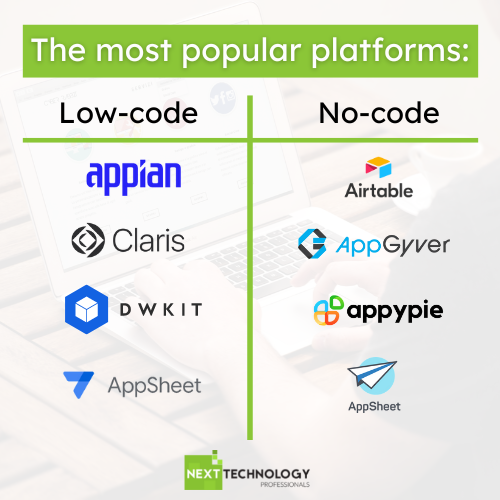Companies and software development specialists are trying to find new ways for more effortless and faster coding. Two of the recently trending approaches are low-code or no-code development. What are their principles, what is the difference between them, and can they revolutionize the coding process?
If you want to know the 3 most popular frontend programming languages in 2022, read our article.
What are no-code and low-code development?
Low-code and no-code development means using a type of visual software development environment that enables building applications by dragging and dropping its elements and combining them in more complex modules and applications. Using a no-code or low-code approach requires a less sophisticated programming experience and knowledge than traditional programming methods.
With the support of low-code or no-code development, it is possible to build several applications or software contributing to business process management, digital transformation, and utilizing modern technologies. They support both professional developers and programming adepts or different kinds of professionals (business owners, business analysts, administrators) to build software without the need for writing the code line by line. According to the Mendix survey, 70% of developers with no programming experience learned to create low-code applications in just one month, and 28% in two weeks.
How do no-code and low-code development work?
Both types of coding are based on a user-friendly graphical user interface that enables combining elements and third-party applications. These applications are equipped with ready-to-go components, scripts, blueprints, integrations, automation tools, and many more. They also provide tools for prototyping, testing, and ensuring security. Thus, components can be freely rearranged into modules and tested, so the developer can ensure that the app works properly.
No-code and low-code development platforms – the difference
Although both systems offer similar benefits, the approaches themselves are slightly different. Low-code development requires performing some coding, however, the amount of work is lower than in the traditional programming approach. On the contrary, no-code development targets rather nontechnical users who lack coding skills. In this case, they can use no-code systems to build their own business apps. However, those apps are usually less complex and can handle simpler functionalities than those developed in low-code or traditional coding approaches.

Pros and cons of low-code and no-code development
The main advantage of the low-code and no-code approach is the ability to deliver software solutions faster by minimizing the amount of coding. This allows companies to meet customer or employee demand much faster and win over the competition. In addition, they help use resources more efficiently and involve non-technical people in the problem-solving process and make them more self-reliant in improving their daily work.
What’s more, less code leads to fewer bugs, and as a result, application development time becomes even shorter. Low-code and no-code development platforms also enable companies to develop applications for multiple platforms simultaneously. Typically, implementing an application on a single platform is a complex task in itself. By using low-code or no-code, this task becomes the easiest.
However, no-code and low-code programming also come with several challenges. Low-code applications can cause integration problems when combined with older systems. The coding process is also more difficult to analyze for those responsible for creating and overseeing the software. Also, scaling and maintaining applications built by non-technical people can present a number of difficulties, as even the no-code approach requires at least basic technical knowledge to make the application successful.
You should also take into account that the market is being conquered by newer and newer solutions and functionalities that are gaining a competitive edge. Using no-code or low-code solutions, you will be forced to accept some limitations of the platform and give up some planned functionality.
The future of no-code and low-code development
With a range of technical and business advantages, the trend for no-code and low-code systems is expected to grow in the coming years. Gartner estimates, that low-code platforms will account for more than 65% of the market by 2024. Based on research and forecasts, the global market for low-code development platforms is expected to generate revenues of $187 billion by 2030 and continue to grow at a rapid pace. However, industry experts predict that they will never fully replace traditional application development and will not completely eliminate human participation.
Although no-code and low-code development definitely require less coding, this does not mean that they enable anyone, regardless of programming skills, to build fully functional applications. These solutions are undoubtedly useful tools for programmers, whom they enable to take on more complex tasks and reduce working time. However, building a successful application that is ready to scale still requires a dose of technical knowledge of software lifecycle management that only professional developers possess. The progressive automation of the coding process, therefore, does not mean the importance of programmers’ work is declining.
If you are looking for professional programmers to join your team, contact us. We will help you hire the best IT professionals!





